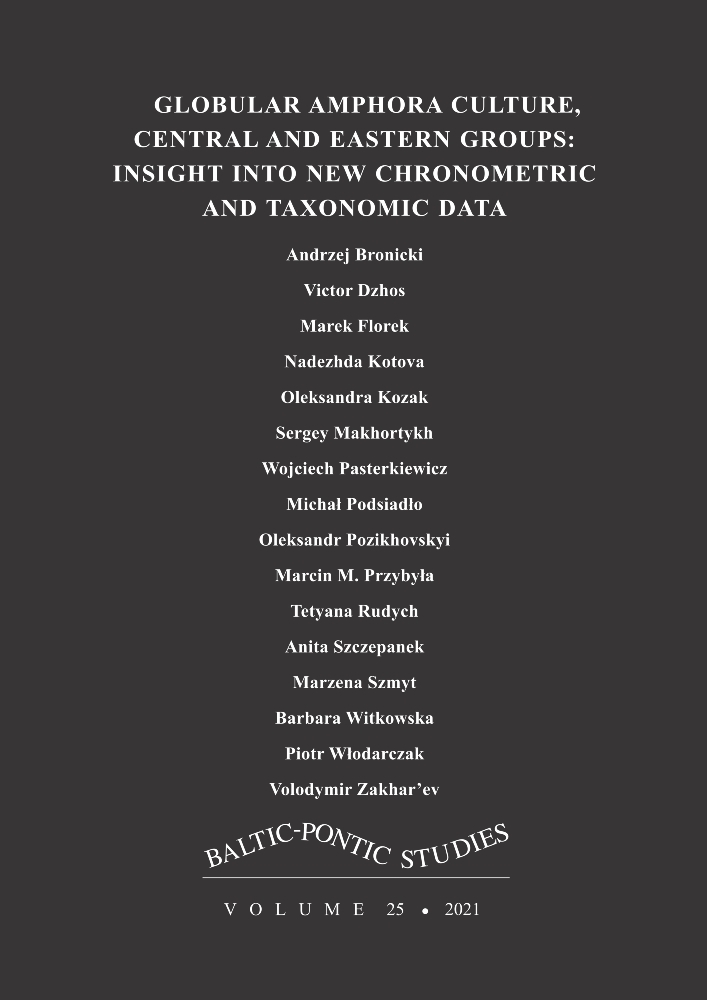Abstract
A funeral complex of the eastern group of the Globular Amphora culture was excavated in an Eneolithic cemetery at the Ostrog-Zeman site, Volhynia, Ukraine, in 2006. The complex consisted of a human tomb and an animal burial located nearby. The tomb, built of small stone slabs and oriented with its long sides along the east-west axis, was divided into two almost identical parts (chambers) – eastern and western. А pot and an amphora were deposited in the eastern chamber, near the transverse wall. At least four people were buried in the western part, destroyed in modern times. The furnishings of this part comprised four amphorae and one bowl. Two meters to the northwest of the tomb, an animal burial without any artefacts was found; it included three skeletons of cattle (bulls) and one of a young pig. Analysis of pottery showed that it belonged to the period around 2950 BC and was synchronous with the early graves of the Volhynian subgroup, e.g. in Tovpyzhyn and Mykolaiv. At the same site, relics of a Globular Amphora culture settlement were also discovered, represented by pottery clusters. To some extent, they confirmed the relative chronology established for the tomb. In the context of these new discoveries, materials from the tomb recovered in 1900 in Mezhyrich-Filvarka (actually – Mezhyrich-Pidvarka), located in the vicinity of Ostrog, are re-analysed and re-published. The relevance of the re-publication stems from the need to clarify the technical details of the description of items from the tomb and their proper graphic documentation.
References
Bergemann S. 2018. Zauschwitz (Landkreise Leipzig): Siedlungen und Gräber eines neolithischen Fundplatzes. Universitätsforschungen zur Prähistorischen Archäologie 314. Human Development in Landscapes 13. Kiel – Bonn.
Kozłowski L. 1924. Młodsza epoka kamienna w Polsce. Lwów.
Krzak Z. 1977. Cmentarzysko na „Gajowiźnie” pod względem archeologicznym. In: J. Kowalczyk (Ed.) Cmentarzysko amfor kulistych w Złotej Sandomierskiej, 9-79. Wrocław – Warszawa – Kraków – Gdańsk.
Libera J. 2009. Czy siekiery krzemienne mogą być wyznacznikiem kultury amfor kulistych? In: H. Taras, A. Zakościelna (Eds) Hereditas praeteriti. Additamenta archaelogica et historica dedicata Joanni Gurba Octogesimo Anno Nascendi, 169–179. Lublin.
Nosek S. 1967. Kultura amfor kulistych w Polsce. Wrocław – Warszawa – Kraków.
Pasterkiewicz W. 2017 Wyniki badań archeologicznych na cmentarzysku z późnego neolitu w Sadowiu koło Opatowa. Materiały i Sprawozdania Rzeszowskiego Ośrodka Archeologicznego 38: 281–289. DOI: https://doi.org/10.15584/misroa.2017.38.14
Pasterkiewicz W. 2020. The first rardiocarbon dates for the Globular Amphora culture cemetery in Sadowie in the Sandomierz Upland. Analecta Archaelogica Ressoviensia 15: 53–75. DOI: https://doi.org/10.15584/anarres.2020.15.5
Pozikhovskyj O., Bunyatyan K. 2012. Pamyatky kultury kulyastykh amfor w okolytsakh Ostroga. Arkheologiya 2: 54–67.
Pozikhovskyj O., Rybicka M. 2019. Ceramika z osady kultury amfor kulistych ze stanowiska Ostrog-Zeman na Zachodnim Wołyniu. In: M. Szmyt, P. Chachlikowski, J. Czebreszuk, M. Ignaczak, P. Makarowicz (Eds) Vir Bimaris. Od kujawskiego matecznika do stepów nadczarnomorskich. Studia z dziejów międzymorza bałtycko-pontyjskiego ofiarowane Profesorowi Aleksandrowi Kośko. Archaeologia Bimaris – Dyskusje 5: 799–812. Poznań.
Pozikhovskyj O., Samoliuk V. 2006. Doslidzhenniya gruntovogo mogilnyka IV-III tys. do n.e. w m. Ostroh-Zeman. Naukowi zapisky. Rivnenskyj obłastnyj kraeznawchyj muzey 4: 155–158. Rivne.
Pozikhovskyj O., Samoliuk V. 2007. Doslidzhenniya gruntovogo mogilnyka doby eneolitu - rannioy bronzy w m. Ostroh. Archeologiczni Doslidzhenniya v Ukraini 2005-2007, 310–313. Kyiv – Zaporizhzhya.
Przybyła M.M., Szczepanek A., Włodarczak P. (Eds) 2013. Koszyce, stanowisko 3. Przemoc i rytuał u schyłku neolitu. Ocalone Dziedzictwo Archeologiczne 4. Kraków – Pękowice.
Sieradzka E. 2017. Stylistyka ceramiky grupy wschodniej kultury amfor kulistych – ujęciestrukturalne. Materiały i Sprawozdania Rzeszowskiego Ośrodka Archeologicznego 38: 13–25. DOI: https://doi.org/10.15584/misroa.2017.38.2
Sveshnikov I.K. 1957. Megalitychni pokhovannya na Zakhidnomu Podilli. Lviv.
Sveshnikov I.K. 1974. Plemena kultury kulastykh amfor. In: Chernysh A.P. (Ed.) Starodavne naselennya Prikarpattya i Volyni (doba pervisnoobshynnogo ladu), 152–158. Kyiv.
Sveshnikov I.K. 1983. Kultura sharovidnykh amfor. Arkheologiya SSSR. Svod arkheologicheskikh istochnikov I-27. Moskva.
Kultura sharovidnykh amfor. In: I.I. Artemenko (Ed.) Arkheologiya Ukrainskoy SSR. Vol. 1, 280–291. Kyiv.
Szmyt M. 2010. Between West and East. People of the Globular Amphora culture in Eastern Europe. Baltic-Pontic Studies 8: 1–349. 2nd edition.
Szmyt M. 2017. Collective graves, flint axes, and cows. The people of Globular Amphora Culture on the Vistula and Odra. In: P. Urbańczyk, P. Włodarczak (Eds) The Past Societies. Polish Lands from the first evidence of human presence to the Early Middle Ages. Vol. 2. 5500 – 2000 BC, 211–273. Warszawa.
Ścibior J., Ścibior J.M. 1990. Sandomierz 78 – wielokulturowe stanowisko z przełomu neolitu i epoki brązu. Badania ratownicze v 1984 roku. Sprawozdania Archeologiczne 42: 157–201.
Wiślański T. 1966. Kultura amfor kulistych w Polsce północno-zachodniej. Wrocław – Warszawa– Kraków.
License
Copyright (c) 2021 Baltic-Pontic Studies, Oleksandr Pozikhovskyi

This work is licensed under a Creative Commons Attribution 4.0 International License.





